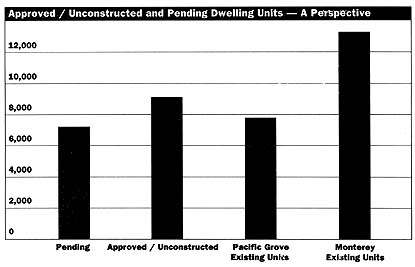The project list (Tables
1 and 2 ) shows that the cities and the county have
either approved or are considering the approval of
15,410 dwelling units, 8.6 million square feet of
commercial and industrial uses, and 1,418 hotel
rooms. The list includes two major categories of
projects: (1)
projects that have been approved and not yet
constructed, and (2)
projects not yet approved, but with applications
filed (pending projects). The project list excludes
the projected buildout of the general plans, the
reuse of Fort Ord, and facilities for 6,800
students at California State University Monterey
Bay (CSUMB). The water and traffic impacts
resulting from the CSUMB facilities are included
because the facilities have been approved or are
pending. To the extent that these plans are
implemented, this project list understates new
growth potential.
This year LandWatch received more complete
information from local jurisdictions than it
received for last year's report. Thus, this year's
project list is more comprehensive than the list
published in 1998. The State of Monterey County
1998 report indicated that Monterey County and the
cities either had approved or were considering the
approval of 15,400 dwelling units, 5 million square
feet of commercial/industrial uses, and 1,145 hotel
rooms. The significant increases shown this year
are largely attributable to previously unreported
projects.
Approved/Unconstructed
Projects
In the Approved/Unconstructed category, local
jurisdictions have approved 8,167 dwelling units
and 701 hotel/motel rooms. Of the
approved/unconstructed units, 853 or 10% will be
affordable to very low-, low-, or moderate-income
residents through deed restrictions. The
approved/unconstructed units will add 81,672 daily
vehicle trips to our roads and highways. (Since
residential trips account for working, shopping,
and other trips, commercial/industrial trips have
been excluded in order to avoid double counting;
therefore, future trips are underestimated).
Construction at CSUMB through 2005 will add another
15,650 daily trips. Approved but unconstructed
commercial/industrial projects total 4,975,099
square feet. These projects would require 76
acre-feet per year from California American Water
Company (Cal Am), between 2,281 and 3,762 acre-feet
per year from the Salinas Valley Ground Water
Basin, and 704 acre-feet of water per year from
other sources. In addition, CSUMB will require 850
acre-feet per year from the Salinas Ground Water
Basin by 2005. Projects in the Salinas Valley would
likely lead to a decline in water use, compared to
agricultural uses.
Table
1 -- Approved and Unconstructed Projects by
Jurisdiction
Pending
Projects
In the Pending Projects category, 7,543 dwelling
units and 717 hotel/motel rooms are in the planning
process. Of the dwelling units pending action, 159
would be affordable to very low-, low-, or
moderate-income residents through deed
restrictions. Affordable housing units generated
from in-lieu fees are not included because the
specific number of affordable housing units that
may be constructed through the use of such fees is
not clearly identified in the project application.
Pending projects would add 75,374 daily trips to
roads and highways. Pending commercial/industrial
projects total 3,688,488 square feet, and would
require 989 acre-feet per year from Cal-Am, between
2,634 and 2,827 acre-feet of water per year from
the Salinas Valley Ground Water Basin, and 32
acre-feet per year from other sources.
Table
2--Pending Projects by
Jurisdiction
Total Approved and
Pending Projects
In total, 15,410 dwelling units, 1,418 hotel/motel
rooms, facilities for 6,800 CSUMB students, and
about 8.6 million square feet of commercial/
industrial uses either have been approved or are
pending approval. Development of 1,226 lots of
record on the Monterey Peninsula (included in the
15,410 residential units) depends on the
availability of additional water. The impacts from
this level of development are significant. A total
of 157,046 additional vehicle trips would be
generated, which represents a 15% increase over
1997 levels. Approved and pending developments
would require 1,065 acre-feet of water per year
from Cal-Am, between 4,664 and 6,204 acre-feet per
year from the Salinas Valley Ground Water Basin,
and 736 acre-feet per year from other sources. This
includes 730 acre-feet of water per year in the
Monterey Peninsula, which is a conservative
estimate of the water demand that was estimated in
the legal lots of record study conducted by the
Monterey Peninsula Water Management District. Aside
from 850 acre-feet per year for CSUMB, most of the
projects requiring water from the Salinas Valley
Ground Water Basin would probably consume less
water than the agricultural uses they are
replacing; however, once water is committed to
urban growth, a long-term entitlement is created,
and dry-year demand is increased.

The approved/unconstructed and pending projects
throughout the county will add more dwelling units
than those which have already been built within the
City of Monterey and 28 times more commercial and
industrial square footage than the Edgewater
Shopping Center in Sand City.
Out-of-County
Impacts
Over the past five years, Monterey County has been
affected by the jobs/housing imbalance created in
Santa Clara County. Between 1995 and 1997, Santa
Clara County created 126,000 jobs, but created only
7,100 housing units. This imbalance has resulted in
a high demand for housing and an increase in
residential land values in Santa Clara County.
Lower- and moderate-income workers have migrated to
Monterey County for more affordable housing. New
housing to accommodate growth pressures often takes
the form of low density suburban sprawl, where
residents are dependent on the auto for access to
job centers.(1)
Recent proposals in Santa Clara County indicate
that this type of pressure on Monterey County is
likely to increase.(2)
|

